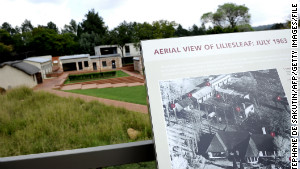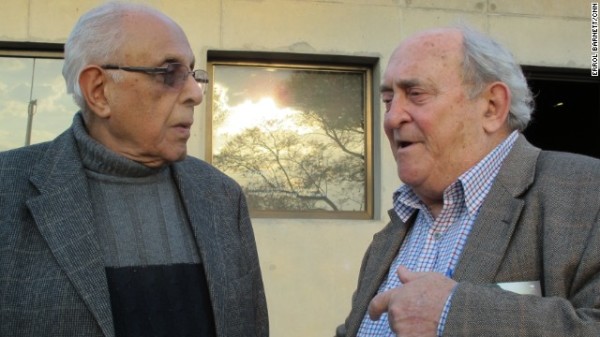From inside a small thatched roof cottage, Ahmed Kathrada watched with horror as a laundry van approaching the main house of Liliesleaf Farm exploded with teams of police officers. He and other anti-apartheid activists hiding out at the farm attempted to jump out of a back window. But they were surrounded, their hopes dashed and their plans for an overthrow of South Africa’s apartheid government were extinguished.
“The vehicles pulled up that way, and there was nothing I could do,” says Kathrada, recalling July 11, 1963, from the same cottage he once called home. Kathrada and close friend Denis Goldberg have returned to Liliesleaf Farm, which has now been turned in to a museum to commemorate 50 years since that fateful day.
Earlier, Nelson Mandela had also used Liliesleaf as a hideout, posing as a domestic worker. But at the time of the raid he was already serving a prison sentence. Mandela had been charged with inciting workers to strike and also leaving the country illegally. He had been to the United Kingdom and more than a dozen African countries trying to shore up financial and material support for the ANC’s armed wing, named MK or “Umkhonto we Sizwe,” which means the tip of the spear.

Parts of Liliesleaf Farm have been reconstructed.
MK was supposed to execute “Operation Mayibuye” a form of guerrilla warfare against the government, taking care not to target civilians. The plan was being discussed just before the police raid. “I tried to flush as many documents as I could down the toilet but it was too late,” recounts Goldberg, who was in the main house at the time.
“Death was in the air there was no doubt. Their hatred was palpable,” Goldberg tells CNN, remembering the disdain officials had for them.
Police would use evidence found at Liliesleaf, which included a journal of Mandela’s travels, to charge him and 19 people found at the farm with sabotage and conspiracy to violently overthrow the government. But the Rivonia trial, as it would become known, would be used as a tool by these activists to show the world what their aim really was.
Goldberg tells CNN, “We would show that the apartheid state was inherently based on violence to maintain itself in power and had to be overturned in the name of humanity and democracy.” Indeed, Mandela knew the power of speech from within the courts and knew there was international media interest in the trial, so he too wanted to show their driving philosophy.
In his autobiography, “Long Walk to Freedom,” Mandela writes: “Right from the start we had made it clear that we intended to use the trial not as a test of the law but as a platform for our beliefs.”
He famously said from the dock, “I have cherished the ideal of a democratic and free society in which all persons live together in harmony and with equal opportunities. It is an ideal which I hope to live for and to achieve. But if needs be, it is an ideal for which I am prepared to die.” Mandela, Kathrada, Goldberg and five others would receive life sentences.
Goldberg would serve 22 years in prison, Kathrada would serve 26 years as the apartheid government became more isolated and weakened economically. Mandela would be released in 1990 and, in 1994, become the nation’s first democratically elected president. But on the 50th anniversary of a milestone in the struggle against apartheid, Goldberg worries that already South Africans are forgetting their sacrifices.
“That’s why I keep saying about Mandela, it was a whole movement. He was a brilliant leader, but it was a whole movement you know. And we forget about people and we shouldn’t.”



Leave a reply